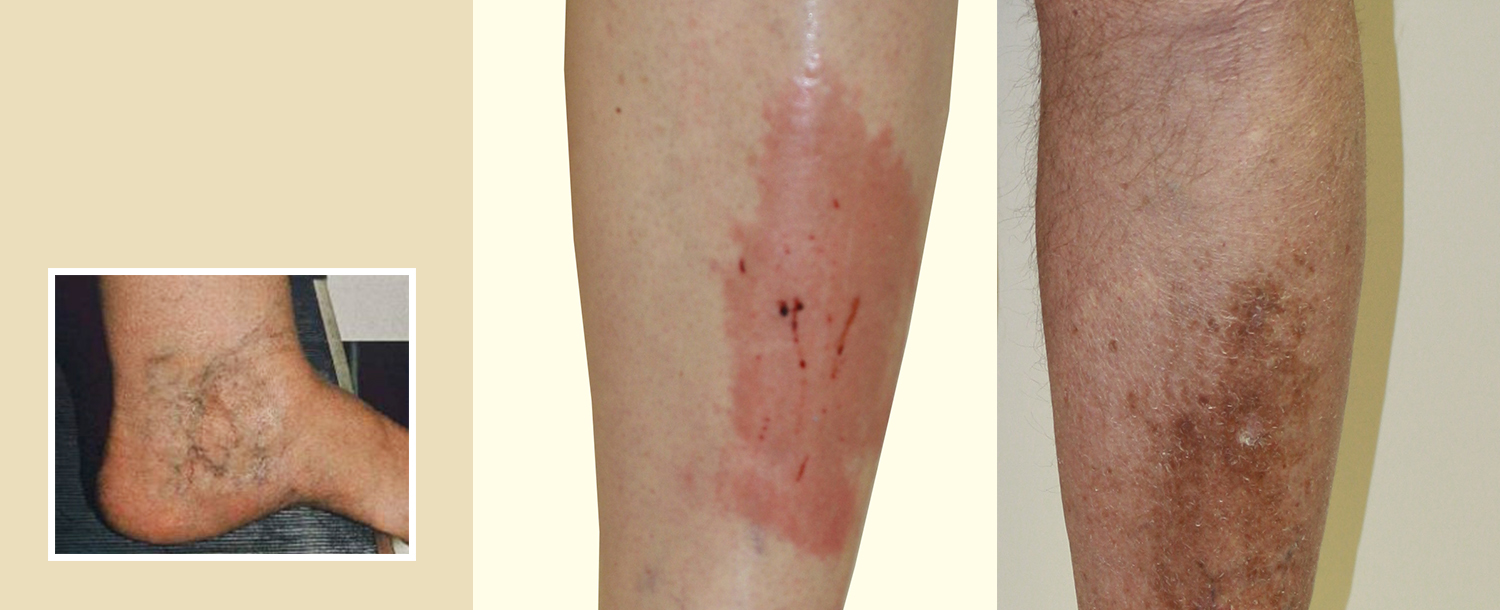
Leg Skin Changes
After years and years of reflux, the constant increased pressure in the veins can cause ankle spider veins. The increased pressure in the veins eventually causes skin inflammation which can result in redness, called venous stasis dermatitis. With continued pressure, the skin eventually becomes reddish brown (hyperpigmentation), and may progress to hard, thick, leathery, dry and itchy skin. In severe cases, skin eventually breaks down to form venous ulcers. Although treatment may not reverse all of the skin changes, treatment aimed at relieving the swelling, decreasing the pressure and decreasing the inflammation in the veins will improve symptoms and possibly close venous ulcers and prevent progression.
Tired, Achy, Heavy, Swollen legs
Pain occurs as the varicose vein and the vein valves become more abnormal. The venous reflux allows blood to pool in the veins, distends and stretches the veins and causes legs to feel: tired, aching, heavy, cramping, swollen, tired, throbbing, restless and itchy. The pooling causes increased pressure inside the veins, stretching the pain fibers which results in pain. Leg pain is caused not only from the direct effects of vein wall stretching, but also from the effects of congestion or pooling in the tissue and muscles. The symptoms usually feel worse at the end of the day. Swelling (edema) is also caused from venous reflux. Blood pooling causes increased pressure in the distended Varicose veins and causes veins walls to become “leaky.” This allows fluid inside the veins to leak outside the vein into surrounding tissue causing swelling (edema.) The swelling can cause the legs to ache and feel heavy.
Venous Ulcers
When venous disease and blood pooling become severe, venous stasis ulcers can occur in the skin. These ulcers usually occur around the ankles and are thought to be caused from long term blood pooling and pressure inside the vein. This increased skin pressure then causes inflammation and skin ulcers begin to form. These venous ulcers can be painful, and topical treatment can be lengthy and frustrating. In many cases, if a venous reflux is diagnosed and considered a cause for the venous ulcer, treating the Varicose veins will redirect the blood flow to healthier veins, decrease the pressure in the area, which will then decrease the inflammation in the skin and most likely close the leg ulcer.
Pregnancy and Varicose Veins
Varicose veins are a common during pregnancy, and they will become larger and more painful with each subsequent pregnancy. After childbirth, most of the pain and swelling will subside, however the varicose veins will never return to normal. Almost 70 percent of women develop spider veins during pregnancy. They begin to develop within a few weeks of conception. The majority of these spider veins will disappear between three and six months postpartum. Because of the hormonal changes and the increased risk of blood clots from those hormonal changes of pregnancy, it is generally recommended to wait and treat varicose veins approximately 4 months after delivery.
